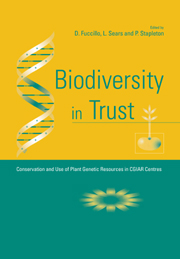Book contents
- Frontmatter
- Contents
- Preface
- Contributors
- Acronyms
- Chapter 1 Cassava
- Chapter 2 The Potato
- Chapter 3 Sweetpotato
- Chapter 4 Other Andean Roots and Tubers
- Chapter 5 Yams
- Chapter 6 Banana and Plantain
- Chapter 7 Cowpea
- Chapter 8 Chickpea
- Chapter 9 Groundnut
- Chapter 10 Lentil
- Chapter 11 Phaseolus Beans
- Chapter 12 Pigeonpea
- Chapter 13 Faba Bean
- Chapter 14 Soyabean
- Chapter 15 Barley
- Chapter 16 Maize, Tripsacum and Teosinte
- Chapter 17 Pearl Millet
- Chapter 18 Small Millets
- Chapter 19 Rice
- Chapter 20 Sorghum
- Chapter 21 Wheat
- Chapter 22 Forages
- Index
Chapter 13 - Faba Bean
Published online by Cambridge University Press: 22 September 2009
- Frontmatter
- Contents
- Preface
- Contributors
- Acronyms
- Chapter 1 Cassava
- Chapter 2 The Potato
- Chapter 3 Sweetpotato
- Chapter 4 Other Andean Roots and Tubers
- Chapter 5 Yams
- Chapter 6 Banana and Plantain
- Chapter 7 Cowpea
- Chapter 8 Chickpea
- Chapter 9 Groundnut
- Chapter 10 Lentil
- Chapter 11 Phaseolus Beans
- Chapter 12 Pigeonpea
- Chapter 13 Faba Bean
- Chapter 14 Soyabean
- Chapter 15 Barley
- Chapter 16 Maize, Tripsacum and Teosinte
- Chapter 17 Pearl Millet
- Chapter 18 Small Millets
- Chapter 19 Rice
- Chapter 20 Sorghum
- Chapter 21 Wheat
- Chapter 22 Forages
- Index
Summary
Faba bean (Vicia faba L.) is an Old World legume that has been called 'poor man's meat'. China and Ethiopia are the major producers, but it also is cultivated in the Mediterranean region, northern Europe, North Africa and West Asia. Faba beans introduced to South America are mostly grown at higher elevations instead of Phaseolus beans. Australia has dramatically increased the area planted to faba bean in the past decade.
BOTANY AND DISTRIBUTION
The genus Vicia belongs to the order Rosales, suborder Rosinae, family Leguminosae and subfamily Papilionaceae and is in the tribe Vicieae (Kupicha 1981). Vicia faba is in the subgenus Vicia and section Faba.
Muratova (1931) subdivided V. faba into two subspecies: paucijuga and eu-fabae. Maxted (1993) placed V. faba in the monospecific section Faba (Miller) Ledeb. and contributed the following infraspecific classification:
V. faba subsp. faba L.
V. faba subsp. faba var. minor Beck
V. faba subsp. faba var. equina Pers.
V. faba subsp. faba var. faba L.
V. faba subsp. paucijuga Murat.
The crop is known by many names in the English language: faba bean, broadbean, field bean, tick bean, horse bean. The common names of faba bean in different countries are: foul, Arabic; haba, Spanish; feve, feverole, French; chechevitza, Russian; zeindo, Chinese.
The varieties major (large-seeded), minor (small-seeded) and equina (intermediate seed size) are also used. Field beans are usually of the minor (tick beans) and equina (horse bean) types.
- Type
- Chapter
- Information
- Biodiversity in TrustConservation and Use of Plant Genetic Resources in CGIAR Centres, pp. 168 - 180Publisher: Cambridge University PressPrint publication year: 1997
- 4
- Cited by

